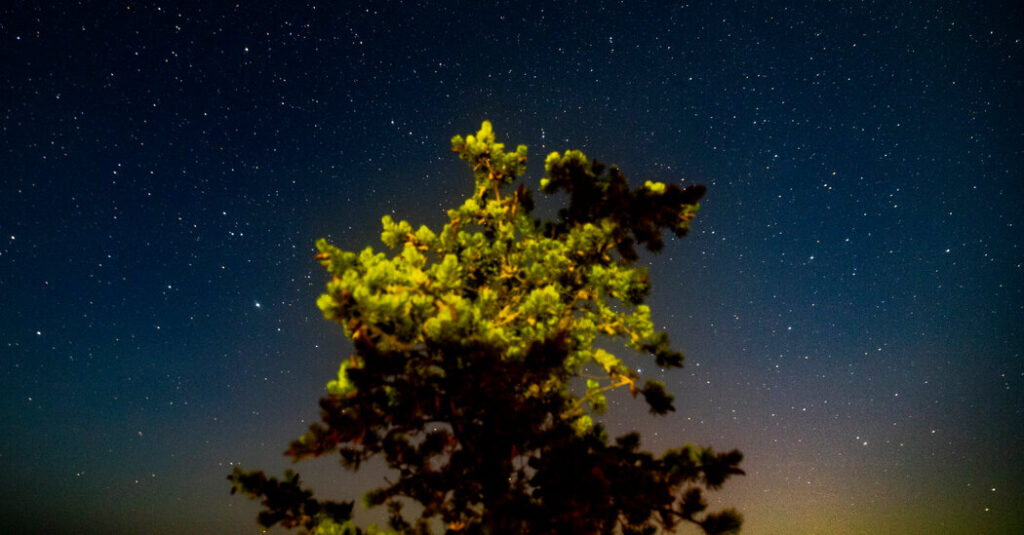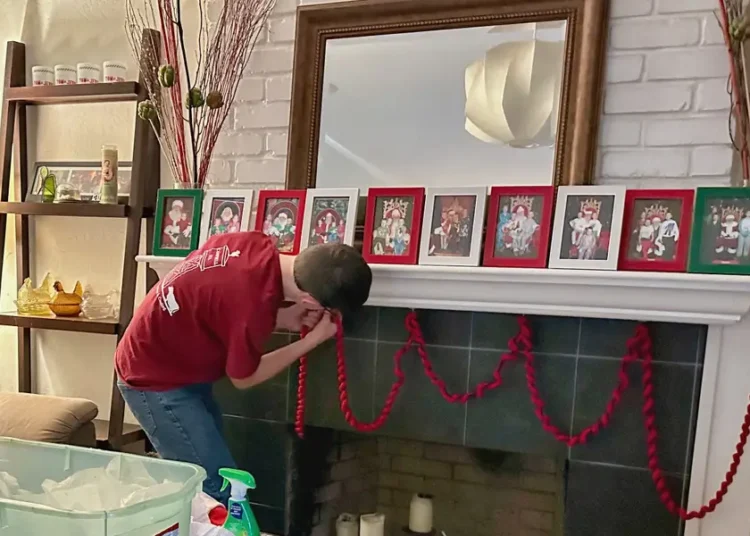On a Saturday in September in Michigan’s Upper Peninsula, a dozen people navigated through the woods to the shore of Lake Superior, where the waves licked softly against the land. Above, a wash of stars filled the blue-black sky, cut in half by the haze of the Milky Way.
Photographers set up cameras and tripods to capture the cosmos, as coarse dark sand, a relic of the region’s mining boom, crunched underfoot. In the early 20th century, a stamp mill dumped millions of tons of the metal-rich grains, a byproduct of copper extraction, in the water.
It was “maybe one of the greatest ecological disasters in the Great Lakes region,” said Tom Oliver, a wildlife ecologist and night sky photographer leading the excursion. The beach “is pretty desolate,” he added. “But it has sweeping views of the sky.”
Today the western Upper Peninsula may be on the cusp of another mining boom, as companies assess the region as a source of critical minerals to support the clean energy transition. Lawmakers and some locals say that a revival of the mining industry would provide a much-needed boost to an economy that has struggled since the last boom went bust. Others, however, fear that mining will further pollute the region — not just its land and water, but also its pristine skies.
In February, a local environmental group launched a campaign called The Right to Night to mitigate that risk. It aims to overturn a Michigan law prohibiting the establishment of dark sky preserves on state land in the U.P., which includes 18 state parks.
“That just struck me as ludicrous,” said Tom Grotewohl, who in 2023 founded Protect the Porkies, the group behind the campaign, to stop a mining project near the region’s Porcupine Mountains State Park (fondly known as the Porkies). “Why would you not have dark sky preserves in a place where the skies are darkest?”
The effort is one example of a broader push across the nation for the legal protection of dark skies. It is also part of a growing conversation about if, and how, natural darkness can coexist alongside industrialization and economic growth.
Initially, light pollution, or the glow from artificial illumination at night, was largely the concern of astronomers, for whom it washed out views of the stars. But increasingly, researchers are finding that artificial light at night can interfere with the behavior of animals, including migrating birds, dung beetles, pollinating insects and baby sea turtles. It can also disrupt the life cycles of tree leaves and increase the amount of carbon released by animals and plants.
“There’s a growing realization that natural darkness is as essential to the environment as clean air, clean water and green space,” said Ruskin Hartley, the executive director of DarkSky International, a nonprofit founded by astronomers in 1987. Across the world, the night sky is growing brighter, though not enough data exists to track light pollution trends at the state or municipal level, he said.
What is clear, however, is that, even in the rural Upper Peninsula, illumination from many small towns, and at least one mine, is visible from space. Light travels far; the glow from Thunder Bay, Canada, more than 80 miles away across Lake Superior, can be seen by some U.P. residents at night.
The Right to Night campaign arose from opposition to the Copperwood Project, a proposed mine that would drill near the Porcupine Mountains. Mr. Grotewohl discovered the ban on dark sky preserves in the U.P. while researching ways to protect the state park. Official recognition of the darkness above, he reasoned, could help conserve the land below, and also signal to stakeholders that the night sky is a valuable resource.
“If the mine does move forward, we want to make sure there’s a best-case scenario,” Mr. Grotewohl said. “Once we start recognizing that darkness is worth protecting, then I think a larger conversation will open up.”
Highland Copper, the company behind the Copperwood Project, said in a statement that it was already committed to adhering to the principles created by DarkSky International for responsible illumination of the mine. “Any outdoor lighting will be directed toward the ground,” the company said. “We are also exploring additional steps, such as berms and tree plantings, to further reduce the impact of light while maintaining what is needed for safety.”
The dark sky ban originated in 2012, when Michigan lawmakers passed a bill designating nearly 21,000 acres of land downstate as dark sky preserves. The bill required outdoor lighting on these preserves to face downward, be fully shielded and use motion sensor technology when possible. It also came with a restriction: No preserves could be established on state-owned land in the Upper Peninsula.
According to Ed McBroom, a state senator representing most of the U.P., lawmakers implemented the ban to prevent land restrictions that could stymie industrial growth. Discussions about a mining revival had already begun; one project on the table, the Back Forty Mine, was made more difficult by a designation of the site on the National Register of Historic Places, and has since stalled.
Mr. McBroom expressed concern that establishing dark sky preserves in the U.P. would be used to similar effect. With only 3 percent of the state’s population, the region maintains deep ties to mining, even as the industry has declined over the past century. “It is still the foundation of our economic success,” he said.
Nevertheless, a petition to reverse the dark sky ban, launched by Protect the Porkies, has amassed thousands of signatures. Julie Brixie, a state representative in lower Michigan, introduced a bill in June to repeal the prohibition. But she has so far been unable to persuade any U.P. legislators to co-sponsor the bill, she said, despite more than 4,800 letters addressed to the region’s lawmakers urging support.
It is not the first time industrialization has encroached on sites of natural darkness. This summer, light from the immigrant detention center known as Alligator Alcatraz trespassed into Big Cypress National Preserve in Florida. Mining has threatened the darkness of Boundary Waters, a wilderness in northeastern Minnesota, as has oil and gas extraction in the Arctic. Even the Atacama Desert in Chile, which boasts some of the darkest skies on Earth, suffers light pollution from industrial facilities.
Many of these places are designated dark sky sites through a program run by DarkSky International. “It’s not about banning all light,” Mr. Hartley said, but “about promoting responsible outdoor light at night.” The organization works with sports fields, marine ports and other facilities to minimize light pollution. “At a large scale, they can definitely coexist,” he said.
Michigan is home to 10 dark sky places. Many are along a lake coast, where, at night, the cosmos above reflect in the waters below. But only one, a golf course at the Keweenaw Mountain Lodge, exists in the Upper Peninsula. Because it is privately owned, the park was able to be certified not through the state, but through DarkSky International.
The certification offers no legal protections. Still, a designated place with resources to offer the public, like telescope lending and stargazing events, has been an advantage, according to Brad Barnett, the executive director of the tourism office in Keweenaw County. It has also drawn attention from the press and incentivized residents to take pride in their night skies.
“The Upper Peninsula clearly has a lot of opportunity in terms of dark sky tourism,” Dr. Barnett said. “So we’re a little dumbfounded by the restriction.”
In September, Dr. Barnett hosted the first Great Lakes Aurora Dark Sky Jamboree, and dozens of Midwesterners gathered for a weekend of science, astrophotography and celestial wonder. “We’re really here to celebrate our dark skies, and the way to celebrate them best is to preserve them, to try to keep them dark,” Melissa Kaelin, the founder of the Michigan Aurora Chasers, said on the third day of the event.
That night, Mr. Oliver, the photographer, led a caravan of vehicles up the pitch-black roads of the Keweenaw to the stamp sand beach, where the skies are, for now, still dark. The amber glow of a bonfire miles away lit up the horizon, a reminder of just how far uninhibited light can travel. Aurora did not make an appearance, so the stargazers reveled in other parts of the universe: the Pleiades star cluster; Andromeda, our galactic neighbor; and Polaris, our north star.
Some turned their eyes and lenses north to soak in the Big Dipper, situated just above the treetops. To the left of the constellation, a tall, thin silhouette rose into the sky — the ruins of a smokestack, from an old copper mine.
Katrina Miller is a science reporter for The Times based in Chicago. She earned a Ph.D. in physics from the University of Chicago.
The post In Michigan’s Upper Peninsula, Locals Fight for ‘The Right to Night’ appeared first on New York Times.




